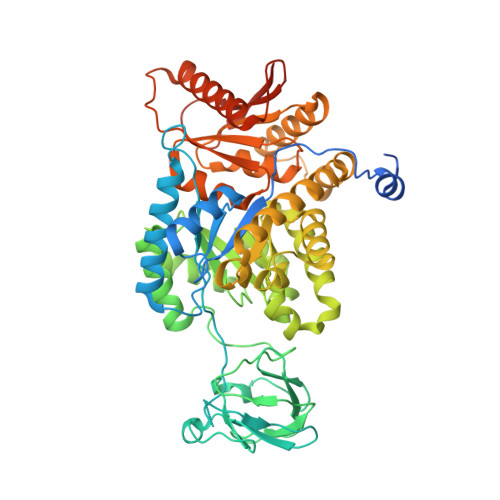Distinctive regulatory properties of pyruvate kinase 1 from Aedes aegypti mosquitoes.
Petchampai, N., Murillo-Solano, C., Isoe, J., Pizarro, J.C., Scaraffia, P.Y.(2018) Insect Biochem Mol Biol 104: 82-90
- PubMed: 30578824
- DOI: https://doi.org/10.1016/j.ibmb.2018.12.010
- Primary Citation of Related Structures:
6DU6 - PubMed Abstract:
Female Aedes aegypti mosquitoes are vectors of arboviruses that cause diseases of public health significance. The discovery of new metabolic targets is crucial for improving mosquito control strategies. We recently demonstrated that glucose oxidation supports ammonia detoxification in A. aegypti. Pyruvate kinase (PK, EC 2.7.1.40) catalyzes the last step of the glycolytic pathway. In most organisms, one or more allosteric effectors control PK activity. However, the kinetic properties and structure of PK in mosquitoes have not been previously reported. In this study, two alternatively spliced mRNA variants (AaPK1 and AaPK2) that code for PKs were identified in the A. aegypti genome. The AaPK1 mRNA variant, which encodes a 529 amino acid protein with an estimated molecular weight of ∼57 kDa, was cloned. The protein was expressed in Escherichia coli and purified. The AaPK1 kinetic properties were identified. The recombinant protein was also crystallized and its 3D structure determined. We found that alanine, glutamine, proline, serine and fructose-1-phosphate displayed a classic allosteric activation on AaPK1. Ribulose-5-phosphate acted as an allosteric inhibitor of AaPK1 but its inhibitory effect was reversed by alanine, glutamine, proline and serine. Additionally, the allosteric activation of AaPK1 by amino acids was weakened by fructose-1,6-bisphosphate, whereas the allosteric activation of AaPK1 by alanine and serine was diminished by glucose-6-phosphate. The AaPK1 structure shows the presence of fructose-1,6-bisphosphate in the allosteric site. Together, our results reveal that specific amino acids and phosphorylated sugars tightly regulate conformational dynamics and catalytic changes of AaPK1. The distinctive AaPK1 allosteric properties support a complex role for this enzyme within mosquito metabolism.
- Department of Tropical Medicine, Vector-Borne Infectious Disease Research Center, School of Public Health and Tropical Medicine, Tulane University, New Orleans, LA, 70112, USA.
Organizational Affiliation:

















